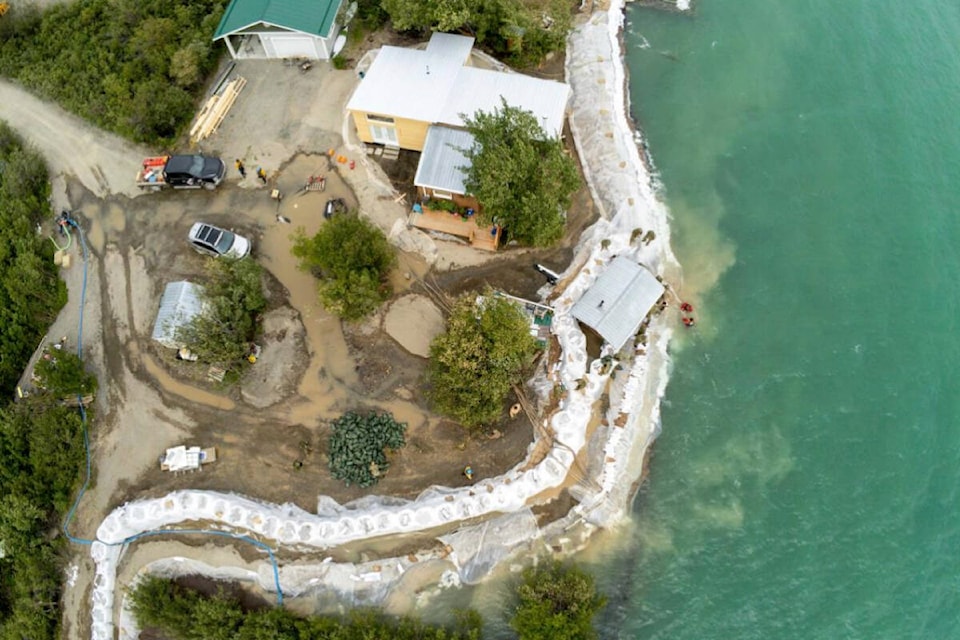The Yukon government achieved “impressive” outcomes during the “largest emergency response in its history” even as responders learned as they went and devised strategies as issues arose to deal with flooding in 2021, according to a review recently posted to the government’s website.
In the summer of 2021 numerous floods hit the Southern Lakes region and other areas, prompting the Canadian military to be called up and a state of emergency to be declared from July 9, 2021, to Sept. 14, 2021.
An after action review of the flood response by Resilience and Foresight Services, dated May 5, 2022, considered the circumstances surrounding the response: the COVID-19 pandemic, an ongoing fire season and relatively little experience that staff and communities have with flooding. Recovery efforts were still underway at the time of the review.
“The reactiveness of this response is not surprising. The impacts of COVID-19 over the previous year meant that planned flood and emergency preparedness efforts were not possible due to limited resources and the priority of the COVID-19 response,” reads the review.
The findings, recommendations and actions for consideration identified in the review present an “opportunity for [the Yukon government] to adapt emergency management practices and policies for a changing risk landscape, one that includes the potential for more frequent and severe climate-related hazards that have not historically impacted the territory.”
The response’s successes were made possible by the dedication and commitment of hundreds of Yukon government, municipal and First Nation staff; residents; volunteers and expert teams from across the country, per the review.
Prior to the 2021 floods, most recommendations from after action reviews of 2007 and 2012 flood events had not been implemented, partly because flooding was not perceived as a major issue.
“This perception is changing,” reads the review prepared by the third-party group for the Yukon government’s emergency measures organization and Yukon Wildland Fire Management.
Harnessing a “culture of preparedness” was expressed by senior leaders, staff and community representatives, according to the review. This shift, which is at the heart of Canada’s emergency management framework, reflects the reality that communities and governments can no longer afford to wait and respond to a growing number of climate-related hazards.
Per the review, the increasing prevalence of flooding in the Yukon translates into a chance for the Yukon government to adapt and build internal capacity to manage and reduce the flood risk.
“The majority of issues experienced during the 2021 floods can be addressed through comprehensive, whole-of-government flood policies, planning and preparedness,” according to the review.
The review notes that a major implication of COVID-19 was that emergency planning and preparedness were delayed.
Emergency and flood plans and policies intended to guide preparedness and response efforts were generally not relied on during the response, per the review.
Review participants reflected that existing emergency plans and policies include “conflicting roles and responsibilities and governance structures.”
“In some cases, departmental flood-policies had been signed off, but roles and responsibilities within those policies had not been resourced for implementation or integrated into staff workplans,” reads the review. It further notes this led to gaps in coordination, confusion over authorities, and uncertainty around roles and responsibilities.
In the review, most interviewees and survey respondents indicated they were not familiar with the Yukon government’s emergency management plan prior to diving into the response.
“There was a strong feeling among the majority of [after action review] participants, that the lack of familiarity of emergency plans and policies extended to senior leaders in [the Yukon government], including elected officials from all parties,” reads the review. That sentiment was also reflected in the previous 2007 and 2012 reviews.
Per the 2021 review, responders noted that there was “a lack of clarity about where private homeowner responsibility ended and government responsibility began.”
The review notes that, despite public belief, there was not more information available than what was being provided about flood risk.
The review offers 21 recommendations such as clarifying flood response policy; improving flood modelling, mapping and forecasting; prioritizing staff safety, mental health and wellness at all stages of the response; and establishing decision-making protocols and training senior leadership and elected officials in emergency management policies and practices.
The status of those recommendations is summed up in another, more recent document.
According to the 2022 after action summary by the Yukon government’s emergency measures organization, dated March 10, one of these recommendations have been met, 14 are in progress and six have not been addressed.
In 2022, the territory saw record-setting snowpack depths across all watershed basins which created a persistent and widespread high risk of freshet, summer lake flooding and high ground water tables, according to the summary. The government’s emergency coordination centre was activated on June 9 in response to escalating flooding and landslide conditions. Within a few days, the emergency measures organization was managing 16 incidents across the Yukon, which dramatically outnumbered past incidents in one time frame.
Per the summary, the response to flooding in 2022 had improved given all the learning from the prior year, but it was also constrained by capacity and not having the recommendations from the previous review in place with an implementation plan.
In terms of the recommendations, conversations are beginning now when it comes to coming up with a territorial framework for emergency management and disaster risk reduction, per the summary. While it has been identified that the Yukon government’s emergency coordination plan needs updating, no timeline has been set for updating the document. Nothing has been formally established regarding continuing to strengthen human resources and staff reassignment processes for emergency management and incident response.
Per the summary, all recommendations are being considered at varying levels of feasibility and expediency of completion. The summary indicates the emergency measures organization and protective services will “continue to document efforts to meet recommendations as they change and evolve with time and to be better suited for future events.”
Contact Dana Hatherly at dana.hatherly@yukon-news.com
